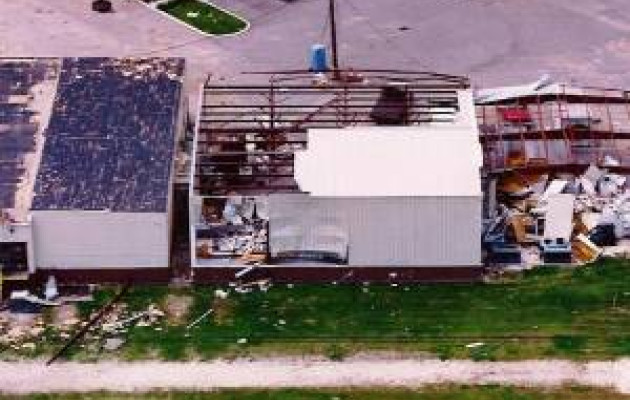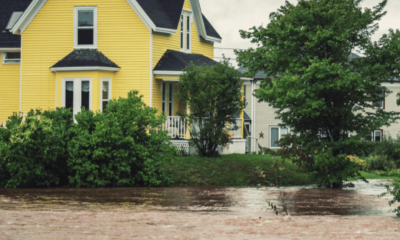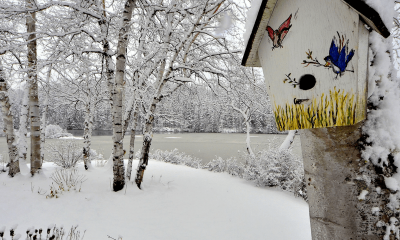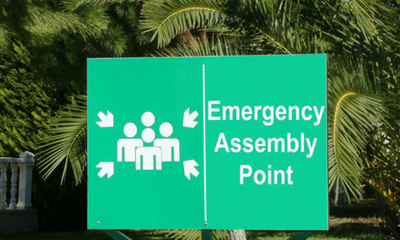What Can Cause Roof Failures?
When it comes to protecting your property from damage, roof failure is just one of many things homeowners and business owners should be mitigating against. Knowing the risk factors can help keep your home or business safe in the event of heavy rain, winter weather and more.
Water buildup
Water buildup on a roof can occur at any time of the year, from heavy rainfall or large amounts of snow. Flat roofs pose more of a problem than sloped roofs, which allow the water to slide off. Schools, warehouses and similar buildings are at the greatest risk because they typically are built with flat roofs, while residential buildings often have sloped roofs.
In April 2016, nearly 20,000 gallons of water broke through the ceiling of a prep school in Mississippi. The incident occurred after school hours when just a small number of people were there and nobody was seriously injured, but the gushing water swept through the halls and carried people out the doors with it.
To avoid water buildup that can lead to roof failures and even a collapse, proper drainage should be installed to help remove excess water from the roof, and gutters should be kept clean and in working condition. It’s also important to have long enough gutters to handle the amount of water coming off the roof.
Wind
When wind strikes a building, uplift can occur when the pressure below the roof is greater than the pressure above it. Properties along the coast are at a high risk for wind uplift, especially during hurricane season. Roofs under construction are also at a high risk because the full structure has not yet been installed, and therefore it is not equipped to resist the force of wind.
Heavy snowfall
 In areas that experience winter weather, snow and ice accumulation on roofs is a serious risk. According to the Insurance Institute for Business & Home Safety, low-sloped and flat roofs are more likely to accumulate ice and snow, and most residential roofs should be able to support 20 pounds per square foot of snow before it poses a problem to the structure.
In areas that experience winter weather, snow and ice accumulation on roofs is a serious risk. According to the Insurance Institute for Business & Home Safety, low-sloped and flat roofs are more likely to accumulate ice and snow, and most residential roofs should be able to support 20 pounds per square foot of snow before it poses a problem to the structure.
The “danger zones” for snow and ice on a roof are four feet or more of fresh snow, two feet or more of packed or old snow, and four inches or more of ice. If the snow or ice on your roof reaches these dangerous levels, removing it is your best option. To do so you can use a snow rake, which costs around $40, or hire a professional to remove it.
Fallen objects
When a storm hits, heavy winds can cause large objects such as trees and telephone poles to fall on your roof, causing it to damage the structure even when there is no hole present. Taking precautions such as removing tree limbs that hang over your roof can help keep your home safe during a storm. If there are trees on your property that are damaged or dying, they are more likely to snap and should be removed as well.
 Design or construction-related deficiencies
Design or construction-related deficiencies
Proper design and professional workmanship when designing and constructing roofs are essential. Roofs that aren’t sloped or pitched properly or under-designed for the potential load can lead to issues such as water and snow buildup. Having your roof designed and installed by a professional can ensure that it’s both high-quality and safe.
Improperly repairing a roof that’s been damaged can eventually lead to extensive damage as well. If you use materials that are not intended for roof repairs as a quick fix, it can cause serious problems with the entire structure.
Deterioration
The most commonly used materials for roofs in the U.S. are composite or asphalt shingles. These types of roofs should be replaced every 20 years, according to Home Depot’s Pro Referral, while other materials such as clay tiles or metal can last up to 50 years or the life of the building itself.
When gravel on asphalt shingles comes loose, or the roof develops mildew and mold, the roof will likely need to be replaced sooner. Minor damages should be patched up and repaired as they occur to keep your roof in the best possible condition. For example, if your roof incurs dents from a hail storm or shingles are blown off from the wind, damaged or missing shingles should be replaced. Exposed areas from damaged or missing shingles can result in further damage to the roof, such as rot from being exposed to natural elements.
If your roof is worn and the majority of it is damaged, it is best to replace the entire structure instead of making individual repairs that likely will not hold up over the long term.
For additional information, visit:
- "Things Our Public Adjusters Want You to Know About Property Damage Claims"
- Podcast: "How to Make the Most of an Underinsured Loss"
- "What to Expect Following a Disaster: Costs, Clean-Up and Coverages"
If your home or business suffers from a roof failure, Adjusters International is here to help. Contact us today to learn how our public adjusters can help settle your roof failure insurance claims.












